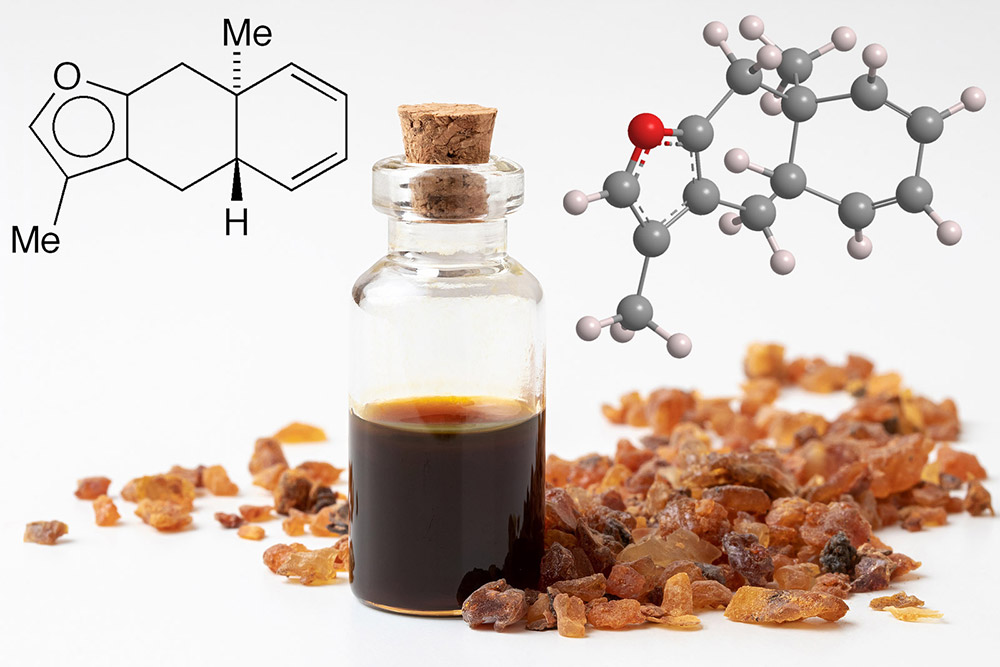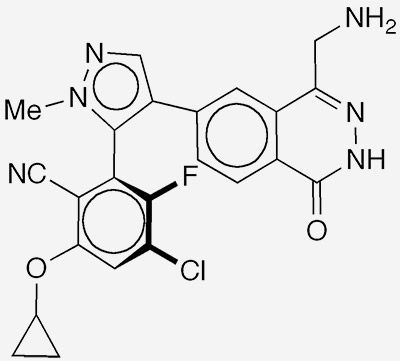What molecule am I?

Myrrh is a resin that occurs in some species of trees in the genus Commiphora that grow in Asia, Africa, and South America. Myrrh is especially prevalent in C. myrrha, which grows in the Arabian Peninsula (Oman and Yemen) and northeastern Africa (Djibouti, Ethiopia, Somalia, and northeast Kenya).
Myrrh resin and the oil derived from it have been used for millennia as a fragrance and medicine. Along with frankincense1, it is familiar as a gift offered to the Christ child by the Magi in the Christian gospel.
In 1983, Carl Heinz Brieskorn* and Pia Noble at the University of Würzburg (Germany) identified furanoeudesma-1,3-diene and two other aroma compounds in the essential oil of myrrh. Thirteen years later, Jose R. Pedro and co-workers at the University of Valencia (Burjassot, Spain) described the stereoselective synthesis of furanoeudesma-1,3-diene from the drug santonin2. The synthetic product was identical to furanoeudesma-1,3-diene obtained from C. myrrha.
Also in 1996, Piero Dolara and colleagues at the University of Florence (Italy) reported that furanoeudesma-1,3-diene and other myrrh components exhibited analgesic effects in laboratory mice They showed that the compound binds to opioid receptors in brain membranes and that the analgesic effect was completely reversed by administering naloxone3. Their finding explains the use of myrrh as a pain killer in ancient times.
1. Frankincense’s key fragrance components are the olbanic acids, last week’s Molecules of the Week.
2. CAS Reg. No. 481-06-1.
3. CAS Reg. No. 465-65-6.
Furanoeudesma-1,3-diene hazard information
| Hazard class* | GHS code and hazard statement |
|---|---|
| Not a hazardous substance or mixture |
*Globally Harmonized System (GHS) of Classification and Labeling of Chemicals.
Molecule of the Future
A complex of the enzyme protein arginine methyltransferase 5 (PRMT5) and 5′-methylthioadenosine (MTA) is associated with the lower expression of the S-methyl-5′-thioadenosine phosphorylase gene (MTAP) in some types of cancers. Several researchers have identified MTAP-deleted cancer cells as having enhanced sensitivity to the loss of PRMT5.
In 2022, Christopher Smith and colleagues at Mirati Therapeutics (San Diego) and other institutions reported that the fluorobenzonitrile derivative MRTX17191 is a lethal inhibitor of the PRMT5–MTA complex. They described MRTX1719 as a potent, selective binder to the complex that selectively inhibits PRMT5 activity in MTAP-deleted cells in contrast to MTAP wild-type cells.

This past May, Michal Achmatowicz and co-workers, also at Mirati, followed up with a scalable, atroposelective synthesis of MRTX1719. (Atropisomers are stereoisomers that are differentiated by the hindered rotation of two parts of a molecule around a single bond.) In the case of MRTX1719, the bond with hindered rotation connects the molecule’s benzene and pyrazole rings. The last step of the authors’ synthesis is the use of an innovative continuous-flow process to convert racemic MRTX1719 to a 98.4% enantiomeric excess of the active (M)-atropisomer.
1. CAS Reg. No. 2629314-96-9; 2-{4-[4-(aminomethyl)-1,2-dihydro-1-oxo-6-phthalazinyl]-1-methyl-1H-pyrazol-5-yl}-4-chloro-6-(cyclopropyloxy)-3-fluorobenzonitrile.
Molecule of the Future
Once a month we bring you a newly discovered or developed molecule that has important implications for the future of chemistry or society in general. Look for it the third week of each month. Learn more about this month's Molecule of the Future below.
We're looking for more molecules of the future!
Do you have a suggestion for the next molecule of the future? Send your idea to MOTW.
This molecule was suggested by a reader. We present almost all of the molecules suggested by our readers. If you have a molecule you would like us to consider, please send us a message. And thank you for your interest in Molecule of the Week! —Ed.
Furanoeudesma-1,3-diene fast facts
| CAS Reg. No. | 87605-93-4 |
| SciFinder nomenclature | Naphtho[2,3-b]furan, 4,4a,8a,9-tetrahydro-3,5,8a-trimethyl-, (4aS,8aS)- |
| Empirical formula | C15H18O |
| Molar mass | 214.30 g/mol |
| Appearance | Colorless to pale yellow oil |
| Boiling point | 155–157 °C |
| Water solubility | Slight |

Learn more about this molecule from CAS, the most authoritative and comprehensive source for chemical information.
Molecule of the Week needs your suggestions!
If your favorite molecule is not in our archive, please send us a message. The molecule can be notable for its current or historical importance or for any quirky reason. Thank you!
Stay Ahead of the Chemistry Curve
Learn how ACS can help you stay ahead in the world of chemistry.

